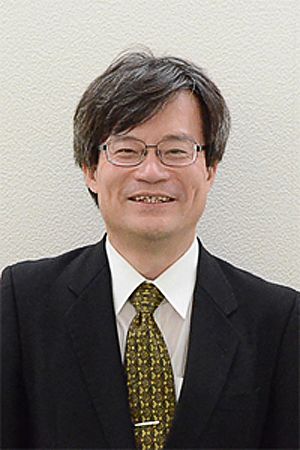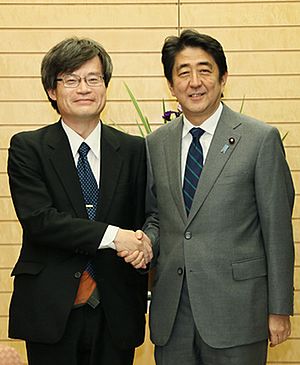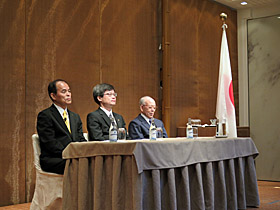Hiroshi Amano facts for kids
Quick facts for kids
Hiroshi Amano
天野 浩 |
|
|---|---|
 |
|
| Born | September 11, 1960 Hamamatsu, Japan
|
| Alma mater | Nagoya University |
| Known for | Blue and white LEDs |
| Awards | Nobel Prize in Physics (2014) Person of Cultural Merit (2014) Order of Culture (2014) Foreign Member of National Academy of Engineering (2016) |
| Scientific career | |
| Institutions | Nagoya University |
| Doctoral advisor | Isamu Akasaki |
Hiroshi Amano (天野 浩, Amano Hiroshi, born September 11, 1960) is a Japanese physicist, engineer and inventor specializing in the field of semiconductor technology. For his work he was awarded the 2014 Nobel Prize in Physics together with Isamu Akasaki and Shuji Nakamura for "the invention of efficient blue light-emitting diodes which has enabled bright and energy-saving white light sources".
Amano was elected as a member of the National Academy of Engineering in 2016 for the development of p-type gallium nitride (GaN) doping, enabling blue semiconductor LEDs.
Contents
Early life and education
Amano was born in Hamamatsu, Japan, on September 11, 1960. He received his BE, ME and DE degree in 1983, 1985 and 1989, respectively, from Nagoya University.
During elementary school days, he played soccer as a goalkeeper and softball as a catcher. He was also passionate about amateur radio and despite hating studying, he was good at mathematics. Upon entering high school, he began taking his studies seriously and became a top student by studying every day late into the night.
Career
From 1988 to 1992, he was a research associate at Nagoya University. In 1992, he moved to Meijo University, where he was an assistant professor. From 1998 to 2002, He was an associate professor. In 2002, he became a professor. In 2010, he moved to the Graduate School of Engineering, Nagoya University, where he is currently a professor.
He joined Professor Isamu Akasaki's group in 1982 as an undergraduate student. Since then, he has been doing research on the growth, characterization and device applications of group III nitride semiconductors, which are well known as materials used in blue light-emitting diodes today. In 1985, he developed low-temperature deposited buffer layers for the growth of group III nitride semiconductor films on a sapphire substrate, which led to the realization of group-III-nitride semiconductor based light-emitting diodes and laser diodes. In 1989, he succeeded in growing p-type GaN and fabricating a p-n-junction-type GaN-based UV/blue light-emitting diode for the first time in the world.
Known to be keen on research, Amano's laboratory was always lit late at night, such as weekdays, holidays, New Year's Day, and was called "no night castle". According to his students in the laboratory, Amano has an optimistic and temperate personality, and is never angry.
Recognition
Awards and honors

- 1994 – Fifth Optoelectronics Conference A Special Award
- 1996 – IEEE/LEOS Engineering Achievement Award
- 1998 – Japanese Journal of Applied Physics Award for the best review paper
- 1998 – British Rank Prize
- 2001 – Marubun Academic Award
- 2002 – Takeda Award
- 2003 – SSDM Award
- 2004 – Tokyo Tech 1st P&I Patent of the Year Award
- 2008 – Paper Award, JACG, Japan
- 2014 – APEX/JJAP Editorial Contribution Award der Japan Society of Applied Physics
- 2014 – Nobel Prize in Physics
- 2014 – Person of Cultural Merit, the Japanese Government
- 2014 – Order of Culture, the Japanese Emperor
- 2015 – Chunichi Culture Award
- 2015 – Special Achievement Award, Institute of Electronics, Information and Communication Engineers
- 2015 – Prizes for Science and Technology (Research Category) by the Minister of Education, Culture, Sports, Science and Technology
- 2015 – Sangakukan Award for Distinguished Contributions, Cabinet Office (Japan)
- 2015 – Asia Game Changer Award
- 2015 – 10th Achievement Award (Isamu Akasaki Award), JACG, Japan
- 2015 – Maruhachikai Award
- 2016 – Compound Semiconductor Electronics Achievement Award, Japan Society of Applied Physics, Japan
- 2018 – Gold Medal, Comenius University, Slovakia
Honorary doctorates
- 2016 – National University of Mongolia, Mongolia
- 2016 – University of Padova, Italy
- 2016 – Blaise Pascal University, Clermont Auvergne University, France
- 2017 – University of Valle, Guatemala
- 2017 – Linköping University, Sweden
- 2019 – Novosibirsk State University, Russia
Regional honorary title
- 2015 – Honorary citizenship of Shizuoka prefecture
- 2015 – Honorary citizenship of Hamamatsu City
- 2015 – Aichi Prefecture Academic Honors
- 2015 – Nagoya City Academic Honors
- 2015 – Honorary citizenship of Aichi prefecture
Learned societies membership
- 2009 – Fellow, Japan Society of Applied Physics
- 2009 – Nistep (National Institute of Science and Technology Policy) Researcher from the Ministry of Education of Japan
- 2011 – Fellow, Institute of Physics
- 2015 – Honorary Fellow, Japan Sweden Society
- 2016 – Foreign Member of the National Academy of Engineering
- 2019 – Foreign members of the Chinese Academy of Engineering
- 2022 – Members of the Japan Academy
Family
Amano's wife is a Japanese lecturer at Comenius University in Bratislava, Slovakia.
Selected publications
- I. Akasaki, H. Amano, K. Itoh, N. Koide & K. Manabe, Int. Phys. Conf. Ser. 129, 851 (1992).
See also
 In Spanish: Hiroshi Amano para niños
In Spanish: Hiroshi Amano para niños
- List of Japanese Nobel laureates



